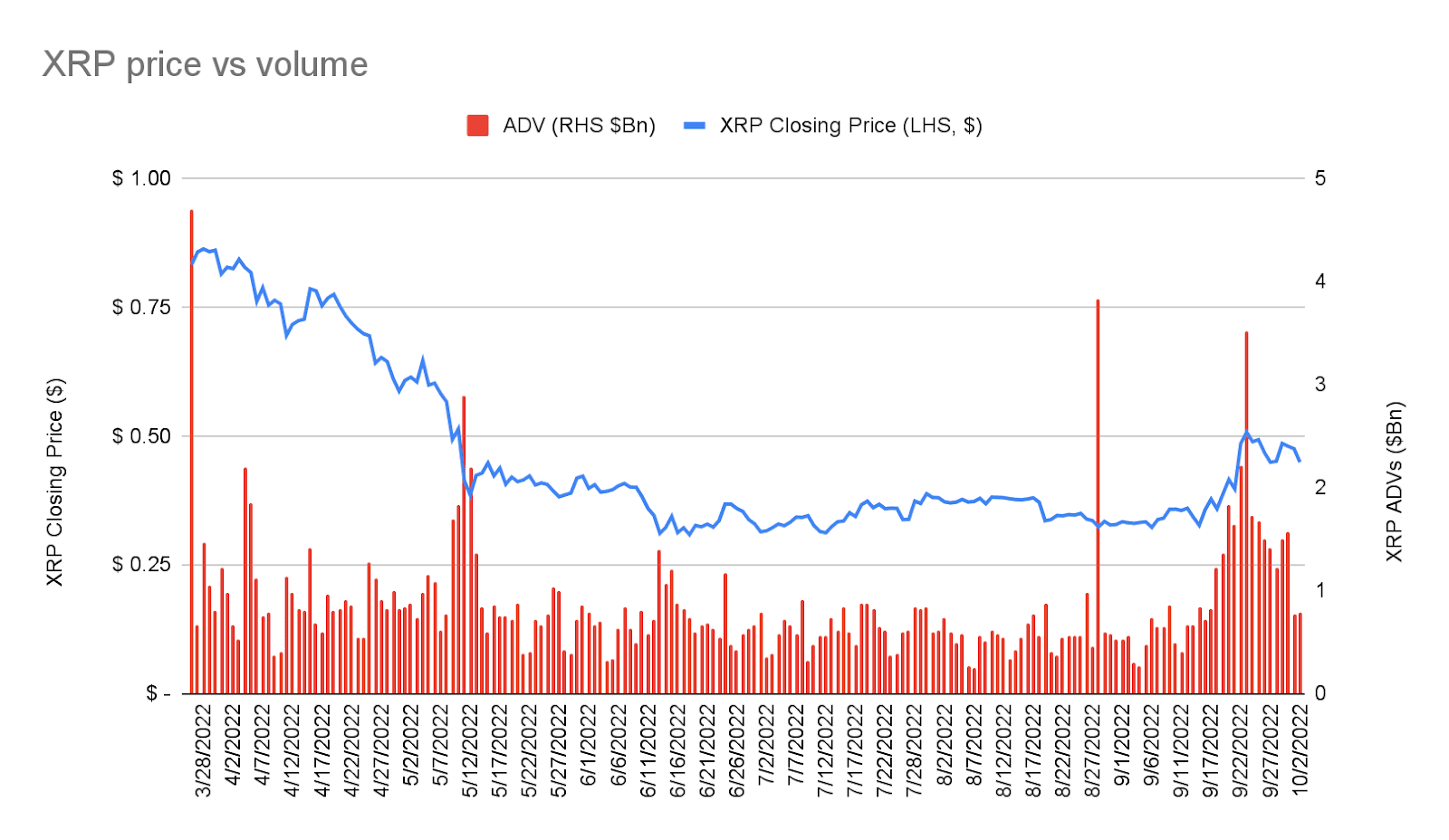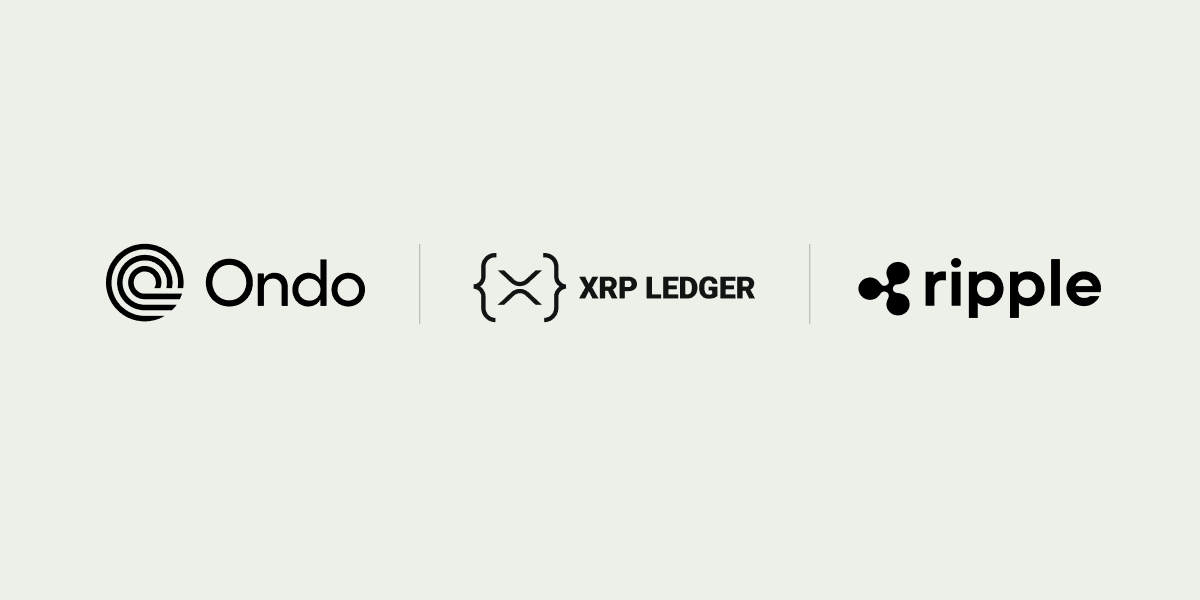Ripple publishes the quarterly XRP Markets Report to voluntarily provide transparency and regular updates on the company’s views on the state of crypto markets, including its quarterly XRP sales, relevant XRP-related announcements, and commentary on market developments over the previous quarter.
As an XRP holder, Ripple believes proactive communication and transparency are part of being a responsible stakeholder. Moreover, Ripple urges others in the industry to build trust, foster open communication and raise the bar industry-wide.
Notable Takeaways
Ripple’s XRP holdings are below 50% of the total outstanding supply for the first time
On-Demand Liquidity (ODL) went live in Brazil, a key market in LATAM
Total XRP sales by Ripple, net of purchases, were $310.68M vs. $408.90M USD the previous quarter
Key Highlight: Ripple’s XRP Holdings
Across Ripple’s various wallets, the amount of XRP held, for the first time, is below 50Bn or 50% of the total outstanding supply. Critics have pointed to the company’s XRP ownership as an indicator that the XRP Ledger is controlled by Ripple. This is not true. The XRP Ledger (XRPL) uses Federated Byzantine Consensus to validate transactions, add new features and secure the network, which means that each validator node gets one vote regardless of how much XRP they own. Ripple currently operates 4 out of 130+ validator nodes on the XRPL.
Crypto Market Summary
In Q3, the macroeconomic environment continued to experience considerable volatility in response to geopolitical and economic events ranging from further escalation in the Russia-Ukraine War to declining economic health in the Eurozone and the UK. In addition, a persistently strong U.S. labor market and stubborn headline inflation prompted what some perceive as a hardline stance towards bringing down inflation by the U.S. Federal Reserve.
The U.S. dollar remained strong against all other paired assets, with the U.S. Dollar Index climbing above 114, a level not seen since 2002. This has been the primary contributor to tepid price action across crypto and FX markets (such as EUR, GBP, JPY and other emerging market currencies).
That said, crypto markets showed signs of resilience by outperforming asset classes such as equities, bonds and FX. Over Q3, bitcoin (BTC) outperformed the S&P 500 by over 5%, and outperformed U.S. treasuries by over 8%. During September, which was a substantially red month for equities and bonds, crypto found strong support across tokens and projects, and managed to trade mostly range-bound. This led to a near term decoupling of correlations with BTC to S&P at 0.5 and with XRP to S&P at 0.21. At the beginning of Q3, these numbers were materially higher.
Leverage in the system remained constant. While trading volumes and open interest lingered at median values for BTC over the last two years, there was a meaningful return to pre-crash levels in ether (ETH). Furthermore, concerted efforts to bring critical traditional markets leveraged infrastructure to crypto were visible. These ranged from prime brokers, clearing houses, OTC derivatives desks and uncollateralized lenders.
Notably, Ethereum's widely anticipated upgrade to Proof-of-Stake, referred to as the Merge, crossed the finish line after years of experimentation and testing. The Merge played a large role in anticipatory positioning and price action by participants but ultimately had little impact on the markets. That said, the effects of the dramatic shift in the tokenomics of ETH are still being realized by the market and will take time to materialize.
While equities continued to sell off, and crypto companies maintained hiring freezes and conducted layoffs, announcements of strong funding deals with respectable valuations were seen. FTX announced it had at least $1B to spend on acquisitions and bailouts and weeks later, the company won a bid to buy Voyager’s assets. In addition, FTX was also rumored to be buying Celsius and to be in talks with investors to raise another round at a valuation of $32B. Lastly, Animoca closed a $110M round led by Temasek and Pantera announced its plans to raise a second blockchain fund. While new money entering the industry remains at a 12 month low ($3.3B this year vs $7B last year according to Crunchbase), this still indicates that conviction, sources of capital and outlook for the future continue to be seen as positive.
NFT Spotlight
The NFT market slowed down with $1.8B of traded volume last quarter, which was 80% lower than the same quarter last year and 76% lower than Q2 this year. As NFT activity slowed, marketplaces struggled for volume. In response, key players brokered new partnerships to expand their reach - for example, OpenSea launched natively on the layer-1 blockchain, Avalanche, adding NFTs from the Avalanche blockchain to its online marketplace. OpenSea’s dominance was challenged by competitors, like Magic Eden and X2Y2, as they gained more traction.
The Metaverse also appeared to have cooled down. DappRadar data suggested that Decentraland, the Ethereum-based virtual world, had only 38 daily active users in its $1.3B ecosystem which was quickly rebutted by Decentraland citing its own metrics and inaccurate user calculations from other platforms. On the regulatory front, Bored Ape creator Yuga Labs is allegedly under investigation by the SEC for unregistered offerings. Yuga Labs was criticized earlier this year after its Otherside drop cost over $100M in gas fees due to badly optimized code.
Despite volume declines and regulatory uncertainty, the market rewarded blue chip NFT collections. Pharrell Williams-backed NFT collection Doodles raised $54M this quarter, valuing the project at $704M. Moreover, Limit Break announced a $6.5M purchase of an advertisement slot to feature a DigiDaigaku commercial in Super Bowl LVII this coming February.
Global Regulation
Last quarter, the White House released its first-ever framework on U.S. crypto regulation focusing on key issues, such as illicit activity in the digital asset space, a potential U.S. central bank digital currency and stablecoin regulation. These guidelines follow an executive order issued in March of this year, calling on federal agencies to examine the risks and benefits of cryptocurrencies.
The SEC continued its game of regulation by enforcement, while still not providing any clarity to the crypto industry. Despite many clamoring for thoughtful policy making, SEC Chair Gary Gensler repeatedly claimed that crypto regulations have been clear for years and the industry does not need any specific rulemaking for projects issuing tokens. In addition, he remarked that multiple federal agencies overseeing securities could undermine market regulation, which only underscores there is a lack of alignment on how to regulate crypto. The Digital Commodity Exchange Act (DCEA), which was introduced earlier this year, seeks to designate the CFTC as the federal agency charged with rulemaking and enforcement of reporting requirements for digital commodities, similar to current requirements in commodity derivatives markets. How Congress chooses to deal with this issue will remain a core area of activity throughout the rest of this year and likely into 2023.
The industry applauded European Union lawmakers as they finalized the Markets in Crypto Assets Regulation (MiCA) which establishes a single set of rules across Europe for crypto regulation, balancing both innovation and consumer protection. In the UK, the new Economic Secretary to the Treasury Richard Fuller stated that the UK government will press forward with its plans to become an international hub for crypto despite the recent leadership changes.
South Korea and Interpol issued an arrest warrant and a red notice, respectively, for Do Kwon, the developer behind the collapsed stablecoin TerraUSD. South Korean prosecutors also ordered the freezing of nearly $40 million worth of crypto assets tied to Kwon as well as a Notice of Order for Return of Passport. Thailand’s largest crypto exchange Bitkub came under regulatory scrutiny from the country’s Securities and Exchange Commission over insider trading. Following that, Siam Commercial Bank called off its plan to acquire the exchange.
Update on the SEC Lawsuit Against Ripple
On Tuesday, September 13, Ripple and the SEC filed their respective summary judgment motions under seal. Unsealed versions were filed and made public on Saturday, September 17. Ripple’s filings argue that the SEC is acting outside their legislative authority and not looking to apply the law. Instead, they are looking to remake the law in the hopes that it can impermissibly expand their jurisdiction far beyond the authority granted to them by Congress. On October 21, both Ripple and the SEC filed public versions of their opposition to the other's summary judgment motion.
In addition, after being ordered six times by the Court over 18 months, the SEC finally produced the documents related to drafts of Hinman’s infamous 2018 speech, which included remarks on why he did not consider offers and sales of BTC and ETH to be securities transactions. Since Hinman’s market moving speech, the SEC continues to deliberately create ambiguity, instead of providing clear guidance, and uses that ambiguity to bring enforcement actions to stifle crypto innovation in the United States.
In terms of next steps, in November, the SEC and Ripple will file reply briefs, and, from there, await the Judge’s decision on the motions. Ripple will continue to fight this case so that the industry can get the regulatory clarity it desperately needs to ensure crypto innovation can flourish in the United States.
The XRP Ledger in the NFT Space
Balmain, the French fashion powerhouse, unveiled the Balmain Thread, its NFT project built on the XRP Ledger, in partnership with mintNFT. The Balmain Thread is the brand’s edition of “The Club”, which is mintNFT’s membership, loyalty, and rewards product. As part of this community, members will have access to in-person and virtual events, rewards, community voting privileges and more.
In addition, Ripple announced the second wave of NFT creators through its Creator Fund. By leveraging the XRP Ledger, creators can take advantage of the blockchain's low-cost, instant settlement functionality, and built-in royalty structures. This cohort of recipients built tokenized use cases specifically in entertainment, media and music. See here for a full list of recipients. Launched a year ago, the Creator Fund is a $250 million program to help creators with the financial, creative, and technical support needed to explore and craft NFTs and other tokenization projects on the XRP Ledger.
XLS-20 Update
In Q1 2022, Ripple developers proposed XLS-20 to introduce native NFT support to the XRPL and provide developers access to NFT minting, trading and burning functionalities. XLS-20 will also bring advanced features like automatic royalties, co-ownership of assets and more—without the need for smart contracts.
Version 1.9.4 of rippled introduced a new amendment to the XRP Ledger (XRPL) protocol to mitigate a potential denial-of-service attack against non-fungible token (NFT) issuers. Shortly thereafter, Ripple configured its four validators to vote in favor of activating the XLS-20 amendment on XRPL Mainnet.
While Ripple is supportive of XLS-20, the outcome of enabling XLS-20 is up to the collective XRPL validators. As of 10/17, over 80% of validators voted in favor of the amendment, and the community anticipates the amendment to go live in Q4 2022.
On-Demand Liquidity: Go Live in Brazil, APAC Growth Continued
Q3 2022 was a strong quarter for On-Demand Liquidity as Ripple entered new markets and customers continue to leverage ODL for use cases beyond individual payments, such as treasury and bulk payments.
Notably, Ripple partnered with Travelex to launch ODL in Brazil, which will initially allow transactions between Brazil and Mexico. Brazil is a key market for Ripple given its importance as an anchor to business in Latin America. Through this partnership, Travelex Bank can offer more affordable cross-border payments to their customers by reducing the need for pre-funded destination accounts, while delivering near instant settlement and providing 24/7/365 access to liquidity.
New and existing customers announced their use of ODL for treasury flows including FOMO Pay, a Singapore-based institutional digital payment solution provider, and long-time customer iRemit, one of the largest non-bank remittance service providers in the Philippines. By expanding its use of Ripple’s On-Demand Liquidity (ODL) solution, iRemit is now able to improve its cross-border treasury flow with greater access to liquidity and real-time settlement.
Disciplined, Responsible Stakeholders: Q3 Sales and Purchases
Last quarter, total XRP sales by Ripple, net of purchases, were $310.68M vs. $408.90M USD the previous quarter. Ripple has continued to sell XRP only in connection with ODL transactions, and ODL volumes have ramped up as Ripple’s ODL business expanded globally. As has been the case since Q4 2019, Ripple did not conduct programmatic sales and has no plans to do so going forward.
Summary of Ripple’s XRP Sales (dollars in millions) | Q2 2022 | Q3 2022 |
|---|---|---|
Total ODL-related sales* | 2,125.92 | 2,819.63 |
Total purchases | 1,717.02 | 2,508.95 |
Net Sales | 408.90 | 310.68 |
Global XRP volume | Q2 2022 | Q3 2022 |
|---|---|---|
ADV XRP (dollars in millions) | 862.59 | 789.72 |
Total XRP volume (dollars in billions)** | 78.50 | 72.65 |
Net sales as % of total volume | 0.47% | 0.42% |
**Note: Figures were compiled using the CryptoCompare API for daily TopTier aggregate volumes which reflects total XRP volume in dollars by exchanges that CryptoCompare lists in the TopTier.
Ripple has been a buyer of XRP in the secondary market and expects to continue to undertake purchases as ODL continues to gain global momentum.
Total sales by Ripple, net of purchases, ended the quarter at 0.42% of global XRP volume according to CryptoCompare TopTier (CCTT) volumes.
Leases
Certain wallets that are being used for XRP sales also provide short-term leases to market makers and participants. This is worth noting given they are often incorrectly interpreted by market participants as sales. XRP associated with leases are ultimately returned to Ripple. The total amount of leases outstanding in Q3 2022 was 91.1 million XRP.
Reported Volume and Price

For the majority of Q3, XRP ADV remained in the $600-$800M range with the exception of a meaningful pick up in daily volumes towards the end of the quarter.
Escrow
In Q3 2022, three billion XRP were released out of escrow (one billion each month) in line with prior quarters and the official escrow arrangement. In total, 2.1 billion XRP were returned and subsequently put into new escrow contracts throughout the quarter. For more information on the escrow process, see here. Note: All figures are reported based on transactions executed during the quarter.
XRPL Interoperability
XRPL’s interchain operability expanded in Q3 as Poly Network integrated XRPL into its cross chain bridging system. This is the third large scale bridge to add XRPL after both Allbridge and Multichain integrated the XRP Ledger earlier this year.
XRPL On-chain Activity (via XPMarket.com)
On-chain Activity | 6/30 | 9/30 |
Trustlines | 10,155,288 | 9,115,964 |
Holders | 4,259,348 | 4,352,222 |
The total number of trustlines in the quarter decreased by over 1M as a number of token projects lost traction during this challenging quarter. With that said, the number of unique holders (wallets) notably increased, reflecting a growth in users on XRPL. The SOLO token, the flagship token of Sologenic, was the most actively traded on-chain this quarter, excluding XRP. Gatehub USD and Bitstamp USD were the most actively traded stablecoins on XRPL.
Building with the XRPL Community
Last quarter, there were a total of 102.6M transactions on the XRP Ledger with $56B via 152.8 billion XRP in volume. The highest single-day volume on the DEX reached $4.4M.
Spotlight: Heirloom + Styngr
Heirloom announced an $8 million raise, co-led by Ripple and Forte, to create a no-code toolkit that will help enterprise firms enter the web3 ecosystem. Built on the XRP Ledger, Heirloom’s software enables enterprises to mint and track a variety of web3 assets, such as non-fungible tokens (NFTs) and verifiable credentials (VCs).
Styngr, a music integration platform for gaming and the metaverse, announced its music integration in an upcoming free-to-play battle royale game Maladroids on the XRP Ledger. In partnership with blockchain developer onXRP and Ripple, this collaboration will see an in-game radio station with a curated playlist of electronic dance music (EDM) in partnership with music label Armada Music, including an industry-first move to release new tracks from Tom Staar and Kryder, two major artists of the genre.
Tokenization of Carbon Credits on the XRP Ledger
Blockchain and crypto is uniquely positioned to support and scale the carbon credits market by solving issues around transparency, traceability and verification. As such, the industry is seeing carbon removal players and climate fintechs lean in to leverage this technology, including the XRPL.
Last quarter, Thallo teamed up with Ripple and others to help its first-of-its-kind blockchain-based marketplace. Leveraging the XRPL, Thallo’s platform will solve the problems with liquidity and pricing in today’s carbon market, making it easier for individuals and corporations to buy and sell high-quality carbon credits. In addition, Ripple invested in Carbon Title, a company that is helping the real estate industry to achieve its carbon neutral goals with blockchain. Real estate construction accounts for nearly 40% of greenhouse emissions, and Carbon Title’s platform helps building owners, developers, and contractors to understand a building’s CO2 emissions over time, purchase high-quality carbon credits, and apply carbon credits to achieve verifiable carbon neutrality.
Ripple has already partnered with leading carbon removal companies and carbon market makers. These include CarbonCure Technologies, whose suite of technologies permanently store captured CO2 in concrete through carbon mineralization; Xange.com, a climate focused fintech (backed by the UN), which is building its carbon credit verification, tokenization and exchange functionality on XRPL; and Invert, a carbon offsetting company that sources and invests in high-quality carbon credit generation projects.
1Correlations were calculated using Crypto Compare’s API and Data, and 3m rolling correlations were used to smooth data.







